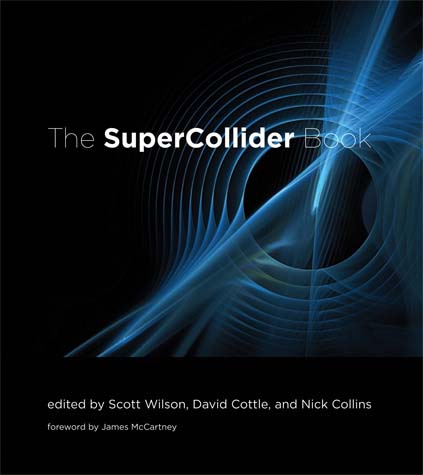Scott Wilson, David Cottle, Nick Collins (eds.): The SuperCollider Book (2011)
Filed under book | Tags: · code, computer music, microsound, music, programming, software, sonification, sound, sound art, sound synthesis

“SuperCollider is one of the most important domain-specific audio programming languages, with potential applications that include real-time interaction, installations, electroacoustic pieces, generative music, and audiovisuals. The SuperCollider Book is the essential reference to this powerful and flexible language, offering students and professionals a collection of tutorials, essays, and projects. With contributions from top academics, artists, and technologists that cover topics at levels from the introductory to the specialized, it will be a valuable sourcebook both for beginners and for advanced users.
SuperCollider, first developed by James McCartney, is an accessible blend of Smalltalk, C, and further ideas from a number of programming languages. Free, open-source, cross-platform, and with a diverse and supportive developer community, it is often the first programming language sound artists and computer musicians learn. The SuperCollider Book is the long-awaited guide to the design, syntax, and use of the SuperCollider language. The first chapters offer an introduction to the basics, including a friendly tutorial for absolute beginners, providing the reader with skills that can serve as a foundation for further learning. Later chapters cover more advanced topics and particular topics in computer music, including programming, sonification, spatialization, microsound, GUIs, machine listening, alternative tunings, and non-real-time synthesis; practical applications and philosophical insigh”s from the composer’s and artist’s perspectives; and “under the hood,” developer’s-eye views of SuperCollider’s inner workings. A Web site accompanying the book offers code, links to the application itself and its source code, and a variety of third-party extras, extensions, libraries, and examples.”
Foreword by James McCartney
Publisher MIT Press, 2011
ISBN 0262232693, 9780262232692
756 pages
Review: Dave Phillips (Linux Journal).
PDF (removed on 2014-2-4 upon request of the publisher)
Code (ZIP)
Book resources (code, video examples)
Book errata
Matthew Fuller, Andrew Goffey: Evil Media (2012)
Filed under book | Tags: · algorithm, art, artificial intelligence, business, code, computing, data, database, event, governance, information, interaction, interface, knowledge, labour, language, machine, management, market, media, media theory, memory, military, networks, philosophy, political theory, politics, power, programming, software

“Evil Media develops a philosophy of media power that extends the concept of media beyond its tried and trusted use in the games of meaning, symbolism, and truth. It addresses the gray zones in which media exist as corporate work systems, algorithms and data structures, twenty-first century self-improvement manuals, and pharmaceutical techniques. Evil Media invites the reader to explore and understand the abstract infrastructure of the present day. From search engines to flirting strategies, from the value of institutional stupidity to the malicious minutiae of databases, this book shows how the devil is in the details.
The title takes the imperative “Don’t be evil” and asks, what would be done any differently in contemporary computational and networked media were that maxim reversed.
Media here are about much more and much less than symbols, stories, information, or communication: media do things. They incite and provoke, twist and bend, leak and manage. In a series of provocative stratagems designed to be used, Evil Media sets its reader an ethical challenge: either remain a transparent intermediary in the networks and chains of communicative power or become oneself an active, transformative medium.”
Publisher MIT Press, 2012
ISBN 0262304406, 9780262304405
235 pages
Review: Nicholas Holm (Media Int’l AU, 2013), Neural (2013).
Evil media on Monoskop wiki
PDF (updated on 2024-4-13)
HTML (added on 2015-8-28)
See also YoHa, et al., Evil Media Distribution Centre, 2013.
Comments (2)Hannah Weiner: Code Poems from The International Code of Signals for the Use of All Nations (1982)
Filed under artist publishing, poetry | Tags: · code, communication, poetry

“I am interested in exploring methods of communication that will be understood face to face or at any distance, regardless of language, country or planet or origin, by all sending and receiving.
For three years I have used the international code of signals to make poems and poetry events, because this code makes available and possible the translation of simultaneous equivalents:
- Flashing light (by Morse): abstract visual,
- Sound signaling (by Morse): abstact aural,
- Live semaphore: motion,
- Fixed semaphore: motion,
- Flag hoists: concrete visual,
- Radio: electronic,
- Words (including equivalent translations in seven different languages.
[..] The amount of information available has more than doubled since WW2. In the next ten years it will double again. How do we deal with it?
- Do we use more than the 5% of the brain now in use?
- Do we process quicker?
- Do we decode information more and put it in another form (not language) so that the present brain can handle it?
- Is there a change in the neural circuits of the brain?
[..] At the moment I am interested in exploring methods of communication through space; considering space as space fields or space solids; through great distances of space; through small distances, such as the space between the nucleus and the electrons of an atom; through distances not ordinarily related to the form of communication used. I am interested in doing this so that we may develop methods of communication that will be understood face to face, or at any distance, regardless of language, country, or planet of origin, by all sending and receiving. For me this implies an understanding of four, five, (and six?) dimensional space; of how what can be transmitted through this space; of how these special dimensions relate to different “states of consciousness” and to different neurological patterns (if any).”
Quoted from Weiner’s “Trans-Space Communication” statement (published in July 1969) written to accompany her performances of Code Poems.
Publisher Open Book Publications, Barrytown/New York, 1982
ISBN 0940170035
28 pages
via waskleist
Weiner at EPC Buffalo
Weiner at PennSound
PDF (no OCR)
Comment (0)
